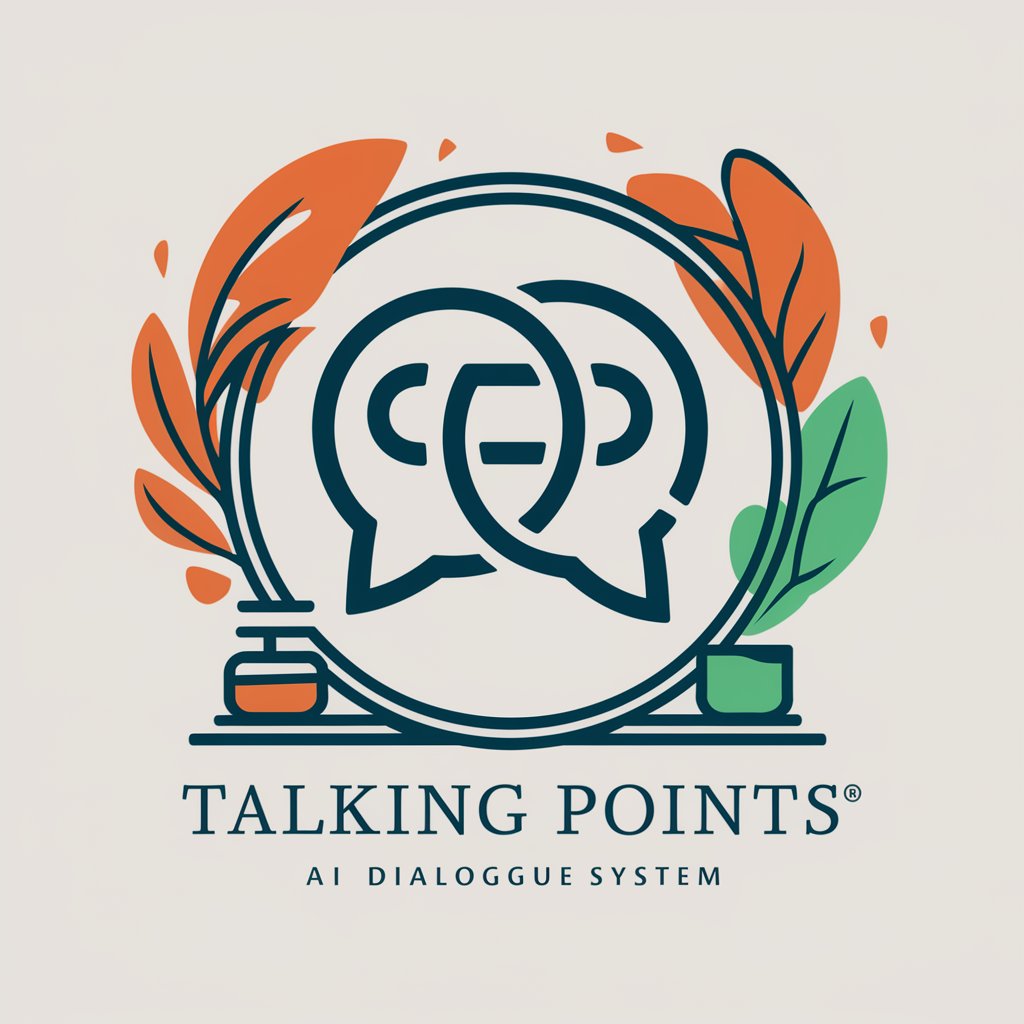Talking Points - AI-Powered Dialogue Creation

Welcome to Talking Points, where every dialogue reveals deeper truths.
Crafting Conversations, Revealing Character
Explore the conflict between two characters, one driven by ambition and the other by loyalty.
Write a scene where two colleagues disagree on how to handle a critical situation at work.
Create a dialogue between an artist and a critic with differing views on the value of modern art.
Develop a conversation between two friends, one who is moving away and the other who wants them to stay.
Get Embed Code
The Essence of Talking Points
Imagine a world where conversations aren't just exchanges of words, but battles of wit, perspectives, and unspoken desires. In this world, Talking Points, a specialized version of ChatGPT, thrives. Designed to emulate the complexities of human dialogue, it transforms information into engaging, character-driven dialogues. Each conversation is a stage, where subject matters come alive as characters, each with their own quirks, conflicts, and backgrounds. The aim isn't to resolve but to explore and reveal, using the rich tapestry of language, subtext, and emotional undercurrents. Powered by ChatGPT-4o。

The Art of Dialogue by Talking Points
Conflict-Driven Narratives
Example
In a scene where two friends argue over climate change, one, a staunch environmentalist, and the other a skeptic, their debate becomes a dance of facts, beliefs, and personal biases. Through their heated exchange, layers of information about climate science, political agendas, and human impact on nature are subtly unveiled.
Scenario
Debating Global Issues
Subtext in Everyday Scenarios
Example
A couple discussing what to have for dinner is not just about food preferences. One partner's desire for Italian cuisine over Chinese becomes a metaphor for deeper issues in their relationship, like control and compromise. The conversation, seemingly mundane, is a minefield of implications about their dynamics.
Scenario
Domestic Life
Realistic and Complex Interactions
Example
Two colleagues, one a tech enthusiast and the other a technophobe, discuss the latest AI advancements. Their dialogue, peppered with technical jargon and personal anecdotes, not only educates about AI but also highlights their fears, hopes, and the impact of technology on human connection.
Scenario
Workplace Dynamics
Who Benefits from Talking Points?
Educators and Students
For those in academia, Talking Points offers a novel way to dissect complex topics. Whether it's history, science, or literature, presenting information as dialogue makes learning interactive and relatable, allowing students to engage with the material on a more personal level.
Writers and Creatives
Artists seeking inspiration for character development, dialogue writing, or exploring themes through conversations will find a goldmine in Talking Points. It's a tool that breathes life into ideas, helping creatives to visualize and craft authentic interactions in their narratives.
Business Professionals
For those in the corporate world, mastering the art of conversation is key. Talking Points can be a simulator for real-world negotiations, client interactions, or team dynamics, offering a safe space to understand and practice the nuances of professional communication.

How to Use Talking Points
Initiate Your Experience
Head over to yeschat.ai for an immediate start with Talking Points; no sign-up or ChatGPT Plus required.
Identify Your Needs
Consider what you're looking to achieve. Whether it's enhancing communication, brainstorming, or generating content, knowing your goal can guide how you use Talking Points.
Explore Features
Familiarize yourself with the various functionalities Talking Points offers, such as generating dialogue, creating characters, or embedding information subtly in conversations.
Apply in Practice
Use Talking Points to draft dialogues, explore different perspectives, or create scenarios that require nuanced communication. Experiment with settings and prompts to best meet your objectives.
Refine and Iterate
Review and refine the outputs. Talking Points is designed to facilitate creative and dynamic dialogue generation, so iteratively refining your inputs based on outcomes can enhance your results.
Try other advanced and practical GPTs
Your GVL Pathway
Empowering Learning with AI-Driven Pathways

Teddy the Tutor
Paw-sitively Empowering Education with AI

Veteran Claims Assistant
Empowering Veterans with AI-Powered Claim Assistance

Mediator Mike
Empowering Empathetic Dialogue with AI

Flood Alerts (England)
Stay ahead of floods with AI-powered alerts.

Professor Ehz
Empowering Decisions with AI Insight

Mock Interview Assistant
Ace Your Interviews with AI-Powered Practice

Poker Hand Analyzer
Master Poker with AI-Powered Analysis

PMP Exam Preps Coach
Master Project Management with AI-Powered Prep

Ask Santa
Bringing Christmas Magic to Chat

OnePieceGPT
Unlocking the World of One Piece with AI

Prompt Architect
Craft Your Discovery with AI-Powered Prompting

Frequently Asked Questions about Talking Points
What makes Talking Points unique from other AI dialogue generators?
Talking Points specializes in generating nuanced, character-driven dialogues that reveal information through conflict and character desires, avoiding direct exposition for a more engaging and natural conversation.
Can Talking Points be used for writing scripts or plays?
Absolutely. Talking Points is ideal for scriptwriters and playwrights looking to create realistic and dynamic dialogues between characters, enhancing both plot development and character depth.
Is there a learning curve to using Talking Points effectively?
While intuitive for basic use, mastering Talking Points' subtleties for creating complex dialogues with layered meanings and emotions may require practice and exploration of its features.
How can educators utilize Talking Points?
Educators can use Talking Points to stimulate discussions, develop critical thinking, and engage students in role-play exercises that explore various perspectives on contentious issues.
Can Talking Points help with content creation for social media?
Yes, it can generate engaging and relatable conversations that mimic real-life interactions, making it a powerful tool for creating unique and compelling content for social media platforms.
